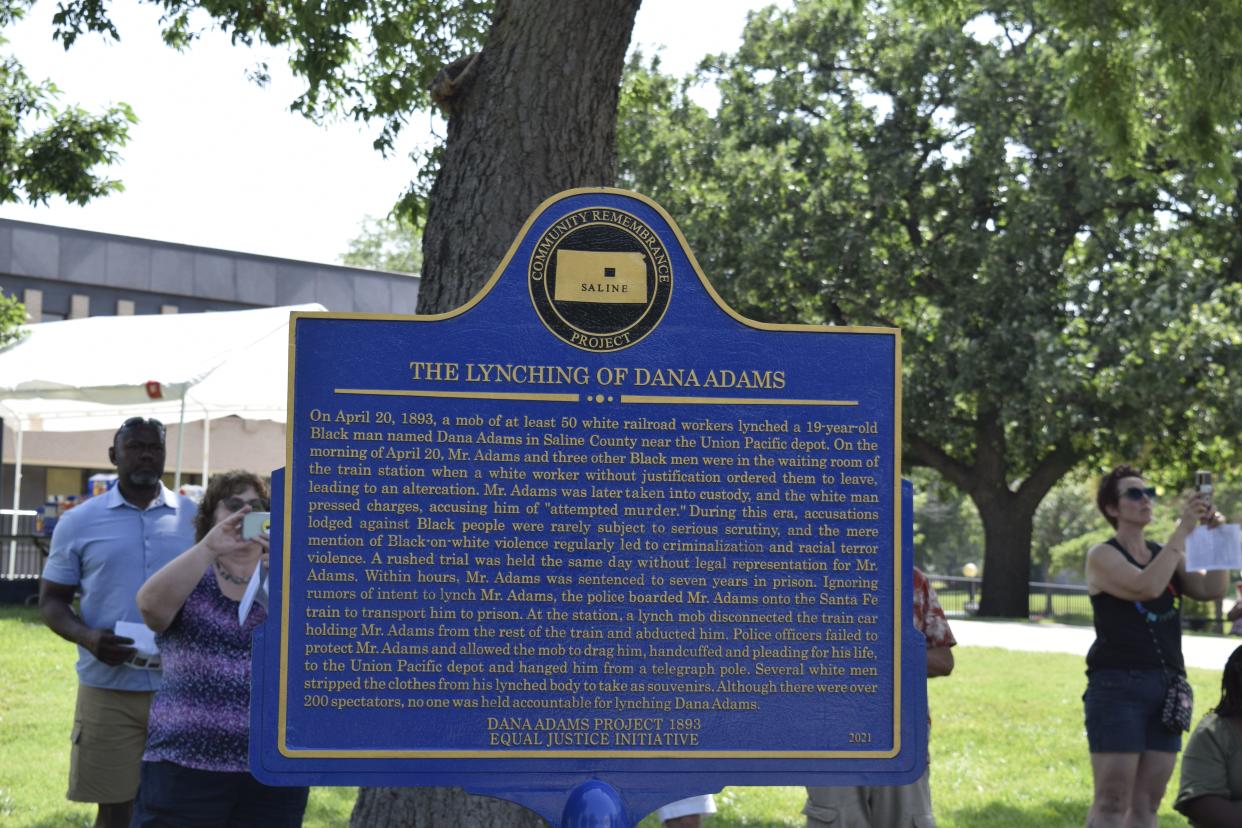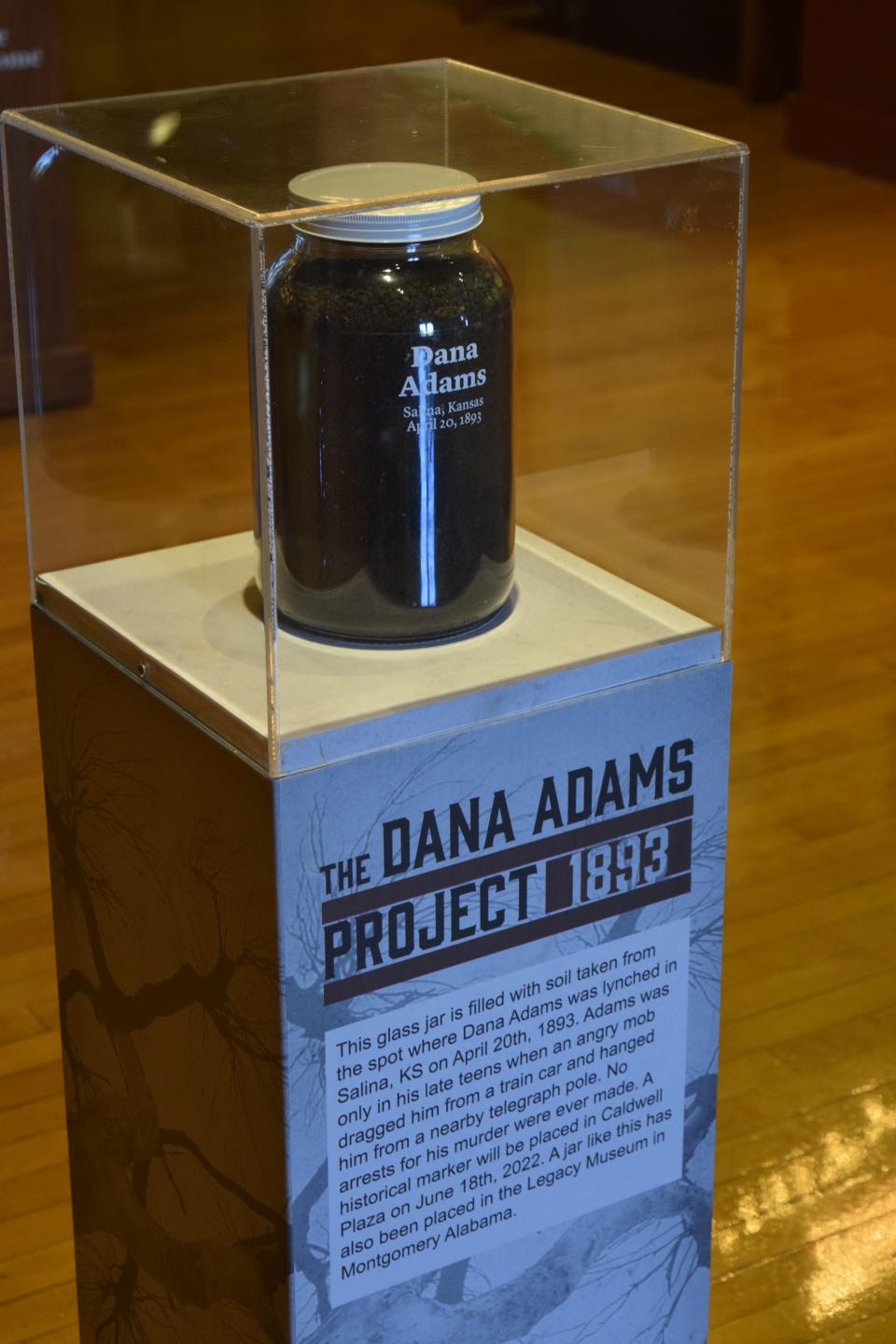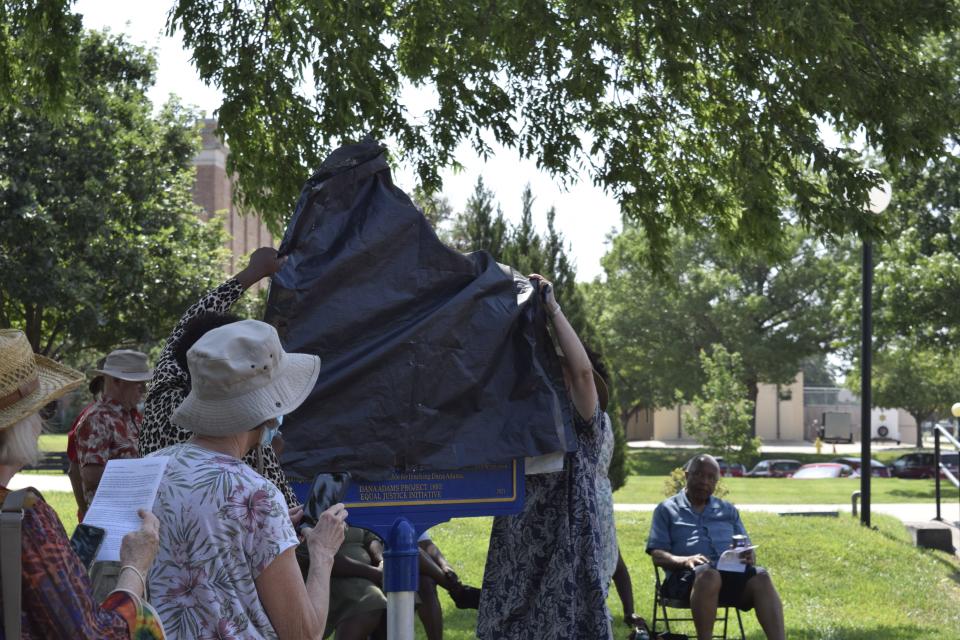Salina community remembers Dana Adams, a Black man lynched in 1893, with historical marker

On April 20, 1893, after being tried and convicted in a court of law for assault of a white janitor, Dana Adams was set to be sent to Leavenworth by train. He never made it out of Salina as he was taken off the train by a mob and hanged from a telegraph pole near the Union Pacific depot.
Almost 130 years later, this troubling incident in the city's history, as well as the life of this Black man that was taken too soon by lynching, will never be forgotten by Salinans and others who visit a new historical marker placed in the Robert Caldwell Plaza Saturday, on the eve of Juneteenth.
"You have to remember, that, when he was lynched, he was pulled off that train purposefully," said Rev. Dee Williamston, one of the organizers of the Dana Adams Project 1893. "They uncoupled the train and he was unceremoniously pulled off and hung from a telegraph pole. This young man was dead within three-and-a-half minutes."
No one was ever arrested for the murder of Adams, who was buried in an unmarked grave in Gypsum Hill Cemetery after his father refused to assume responsibility for the burial, saying the white people had killed him and they should bury him. A marker was placed on the grave during Juneteenth celebrations in 2009.
Another organizer of the project, the Rev. Martha Murchison, said she first heard about the lynching in 2018 after reading news accounts of the opening of the National Memorial for Peace and Justice in Montgomery, Alabama, also known as the Lynching Memorial.
Murchison said she went to the website for the Equal Justice Initiative, which built and runs the memorial and with which the Dana Adams Project is a collaboration.
"It's an interactive website with a red dot for every lynching in the United States," Murchison said.
Murchison is a white woman who grew up in South Carolina. She looked and did not find a recorded lynching in her home county but was not surprised to see red dots in the various communities she pastored in Texas.
One spot on the map did surprise her though, in her current home of Kansas.
"There was this red dot that caught my eye in the middle of the country...in Saline County," Murchison said. "I knew then that I needed to make atonement for what had been done, and I needed to talk about it."
More: Salina celebrates Juneteenth, honors memory of lynching victim Dana Adams

A marker for the community to remember
While the lynching of Adams is one of the most troubling moments in the history of Salina, the organizers of the project said it is a story that needs to be told.
Sandra Beverly a Black woman who has lived in Salina for more than 50 years didn't hear the story of Adams until 2009. She said that in doing research for the project she spoke with many older people in the Black community who did know the story but didn't talk about it because of the fear following the event.
"One of the things that (local newsletter) the Black Word Is said when they did an article about Dana Adams years ago...was that Black African Americans were scared to come out of their houses or go to work for days on end after this happened," Beverly said. "Because if they could do it to (Adams), they could do it to somebody else."
Beverly said she spoke with Joann Bess whose father took her as a child by the site of the lynching and told her about what happened there.
"She told me this in my house, and I sat there and cried," Beverly said. "It just struck me as to how traumatic that had to have been as a child to have your father point to a telegraph pole and tell her they hung somebody from that pole. Somebody that looked like (Bess)."
More: Salinans voted on ordinance to limit the commission's powers. That ordinance is now void
One of the most important things that everyone who spoke during the dedication ceremony Saturday talked about was the importance of telling and retelling Adams's story and other tragic stories in the racial history of this country.
"We need to recognize that this is a negative thing, but lest we learn from history, we are destined to repeat it," guest singer Ramona Malone said. "And the only way we can learn from this is if we know what it is."
Dedication and placement at an important and purposeful site

The place where the marker that was unveiled Saturday was placed was not a random or coincidental location.
Not only is Robert Caldwell Plaza named for Salina's first Black mayor, but Caldwell was also inaugurated as mayor on April 20, 1970, exactly 77 years after Adams's lynching.
The Dana Adams Lynching marker is placed just a few feet away from one that was placed in memory of Caldwell.
Beverly said the plaza was also important for the significance of where in the city it is located,
"The halls of justice are here in (the City-County Building) and the (Salina) Public Library is here," Beverly said. "This is where this marker belongs. Between these two buildings."
This article originally appeared on Salina Journal: Salina dedicates marker in remembrance of Black man lynched in 1893

